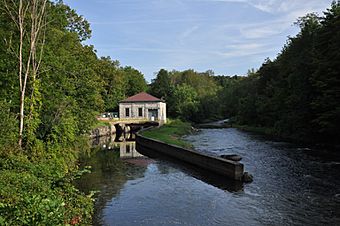Glendale Power House facts for kids
Quick facts for kids |
|
|
Glendale Power House
|
|
 |
|
| Location | Housatonic River off MA 183, Stockbridge, Massachusetts |
|---|---|
| Area | 13.3 acres (5.4 ha) |
| Built | 1905 |
| Architect | F.O. Toquet |
| NRHP reference No. | 82004957 |
| Added to NRHP | June 24, 1982 |
The Glendale Power House is a special old building in Stockbridge, Massachusetts. It sits right by the Housatonic River. This power house was built way back in 1905. It was one of the very first places in the United States to make electricity for a factory!
The building was made for a company called Monument Mills. Because it's so important to history, it was added to the National Register of Historic Places in 1982. Today, the Glendale Power House has been updated. It now uses the river to make clean electricity again!
What is the Glendale Power House?
The Glendale Power House is located a bit southwest of Stockbridge's main town area. It's right next to Massachusetts Route 183 and the Housatonic River. The whole area is quite large, covering over 13 acres.
How Does the Power House Work?
The power house uses water from the river to make electricity. Here's how it works:
- Dam: There's a dam at the northern end of the property. This dam is about 28 feet tall and is made of concrete. It helps to control the river's water flow.
- Power Canal: A long canal, about 1,500 feet long, was dug to carry water from the dam to the power house. This canal is 40 feet wide.
- Power House Building: The main building is made of stone and has a slate roof. Inside, it's one big room. This is where the machines that turn water into electricity used to be. A special crane helped workers move heavy equipment around.
History of the Glendale Power House
The Glendale Power House was built in 1905 by Monument Mills. This company was located in Housatonic. The power house was built on the site of an even older dam from the 1840s. That old dam was used for a paper factory.
The stone used to build the power house actually came from another old factory called the Glendale Woolen Mill. By 1909, this power plant was making half of all the electricity that Monument Mills needed!
The power station stopped working in 1946. Most of its original machines were taken out. But in the 1980s, the property was updated. Now, it makes hydroelectric power again for the main electricity grid. Its four special machines, called turbines, can make 1.07 megawatts of electricity. How much electricity it makes depends on how much water is in the river. If there's a drought, the water level might be too low to run the turbines.



